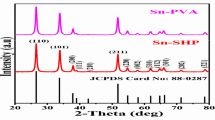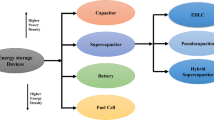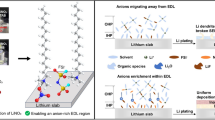Abstract
A novel ionic liquid (IL) 1-ethyl-2,3-dimethylimidazolium tetrafluoroborate ([Emmim][BF4]) with trialkyl substitution imidazolium cation was synthesized, and its binary system blended with acetonitrile (ACN) under different concentrations were prepared and investigated as possible electrolytes for supercapacitors. The physico-chemical properties such as density, viscosity, and electrical conductivity of the binary mixture system were measured from 288.15 to 333.15 K. The temperature dependences of density, viscosity, and electrical conductivity were illustrated and discussed by the Vogel-Fulcher-Tamman (VFT) equation and Arrhenius equation. It was found that the VFT equation was more suitable to [Emmim][BF4] + ACN system. Further, the important characteristics of this IL-based electrolyte for supercapacitors including the maximum operative voltage, the capacitance, the energy density, and power density were measured and calculated by cyclic voltammetry (CV), electrochemical impedance spectrum (EIS), and galvanostatic charge-discharge. The results show that the performance of the electrolyte can be improved with appropriate ratio of IL. When the concentration of the IL increased to 0.8 mol L−1, the maximum operative voltage increased to 5.9 V, and the specific capacitance achieves 142.6 F g−1. It shows the IL-based mixtures with excellent characteristics are applicable as high-voltage electrolytes for supercapacitors.








Similar content being viewed by others
References
Simon P, Gogotsi Y (2008) Materials for electrochemical capacitors. Nat Mater 7:845–854
Pandolfo AG, Hollenkamp AF (2006) Carbon properties and their role in supercapacitors. J Power Sources 157:11–27
Hashmi SA, Updahyaya HM (2002) MnO2-polypyrrole conducting polymer composite electrodes for electrochemical redox supercapacitors. Ionics 8:272–277
Liu S, Dong HF, Du JP, Qin XJ, Shao GJ (2014) MnO2/graphite electrodeposited under supergravity field for supercapacitors and its electrochemical properties. Ionics 20:295–299
Huang GY, Zhang WJ, Xu SM, Li YJ, Yang Y (2016) Microspherical ZnO synthesized from a metal-organic precursor for supercapacitors. Ionics 22:2169–2174
Portet C, Yushin G, Gogotsi Y (2008) Effect of carbon particle size on electrochemical performance of EDLC. J Electrochem Soc 155:A531–A536
Xu B, Wu F, Chen R, Cao G, Chen S, Zhou Z, Yang Y (2008) Highly mesoporous and high surface area carbon: a high capacitance electrode material for EDLCs with various electrolytes. Electrochem Commun 10:795–797
Frackowiak E, Lota G, Machnikowski J, Vix-Guterl C, Beguin F (2006) Optimisation of supercapacitors using carbons with controlled nanotexture and nitrogen content. Electrochim Acta 51:2209–2214
Conway BE (1999) Electrochemical capacitors. Kluwer Academic Plenum Publisher, New York
Portet C, Taberna PL, Simon P, Laberty-Robert C (2004) Modification of Al current collector surface by sol–gel deposit for carbon–carbon supercapacitor applications. Electrochim Acta 49:905–912
Perricone E, Chamas M, Leprêtre JC, Judeinstein P, Azais P, Raymundo-Pinero E, Béguin F, Alloin F (2013) Safe and performant electrolytes for supercapacitor. Investigation of esters/carbonate mixtures. J Power Sources 239:217–224
Lei C, Amini N, Markoulidis F, Wilson P, Tennison S, Lekakou C (2013) Activated carbon from phenolic resin with controlled mesoporosity for an electric double-layer capacitor (EDLC). J Mater Chem A 1:6037–6042
Weingarth D, Noh H, Foelske-Schmitz A, Wokaun R, Kötz A (2013) A reliable determination method of stability limits for electrochemical double layer capacitors. Electrochim Acta 103:119–124
Zhang LL, Zhao XS (2009) Carbon-based materials as supercapacitor electrodes. Chem Soc Rev 38:2520–2531
Denshchikov KK, Izmaylova MY, Zhuk AZ, Vygodskii YS, Novikov VT, Gerasimov AF (2010) 1-Methyl-3-butylimidazolium tetraflouroborate with activated carbon for electrochemical double layer supercapacitors. Electrochim Acta 55:7506–7510
Arbizzani C, Biso M, Cericola D, Lazzari M, Soavi F, Mastragostino M (2008) Safe, high-energy supercapacitors based on solvent-free ionic liquid electrolytes. J Power Sources 185:1575–1579
Béguin F, Presser V, Balducci A, Frackowiak E (2014) Supercapacitors: carbons and electrolytes for advanced supercapacitors (Adv. Mater. 14/2014). Adv Mater 26:2283–2283
Galiński M, Lewandowski A, Stępniak I (2006) Ionic liquids as electrolytes. Electrochim Acta 51:5567–5580
Lazzari M, Mastragostino M, Soavi F (2007) Capacitance response of carbons in solvent-free ionic liquid electrolytes. Electrochem Commun 9:1567–1572
Lazzari M, Soavi F, Mastragostino M (2008) High voltage, asymmetric EDLCs based on xerogel carbon and hydrophobic IL electrolytes. J Power Sources 178:490–496
Mastragostino M, Soavi F (2007) Strategies for high-performance supercapacitors for HEV. J Power Sources 174:89–93
Tanahashi I, Yoshida A, Nishino A (1990) Electrochemical characterization of activated carbon-fiber cloth polarizable electrodes for electric double-layer capacitors. J Electrochem Soc 137:3052–3057
Brandt A, Ramirez-Castro C, Anouti M, Balducci A (2013) An investigation about the use of mixtures of sulfonium-based ionic liquids and propylene carbonate as electrolytes for supercapacitors. J Mater Chem A 1:12669–12678
Schütter C, Neale AR, Wilde P, Goodrich P, Hardacre C, Passerini S, Jacquemin J, Balducci A (2016) The use of binary mixtures of 1-butyl-1-methylpyrrolidinium bis {(trifluoromethyl) sulfonyl} imide and aliphatic nitrile solvents as electrolyte for supercapacitors. Electrochim Acta 220:146–155
Huang PL, Luo XF, Peng YY, Pu NW, Ger MD, Yang CH, Wu TY, Chang JK (2015) Ionic liquid electrolytes with various constituent ions for grapheme based supercapacitors. Electrochim Acta 161:371–377
Zhang QG, Li MC, Zhang XY, Wu XY (2014) The thermodynamic estimation and viscosity, electrical conductivity characteristics of 1-alkyl-3-methylimidazolium thiocyanate ionic liquids. Z Phys Chem 228:851–867
Zhang QG, Lan YL, Liu HW, Zhang XY, Zhang XL, Wei Y (2016) Estimation and structural effect on physicochemical properties of alkylimidazolium-based ionic liquids with different anions. J Chem Eng Data 61:2002–2012
Liu CY, Ma XD, Xu F, Zheng LP, Zhang H, Feng WF, Huang XJ, Armand M, Nie J, Chen HL, Zhou ZB (2014) Ionic liquid electrolyte of lithium bis(fluorosulfonyl)imide/N-methy-N-propylpiperidiniumbis (fluorosulfonyl)imide for Li/natural graphite cells: effect of concentration of lithium salt on the physicochemical and electrochemical properties. Electrochim Acta 149:370–385
Wang B, Al Abdulla W, Wang D, Zhao XS (2015) A three-dimensional porous LiFePO4 cathode material modified with a nitrogen-doped graphene aerogel for high-power lithium ion batteries. Energy Environ Sci 8:869–875
Wang B, Xie Y, Liu T, Luo H, Wang B, Wang CH, Wang L, Wang DL, Dou SX, Zhou Y (2017) LiFePO4 quantum-dots composite synthesized by a general microreactor strategy for ultra-high-rate lithium ion batteries. Nano Energy 42:363–372
Wang B, Liu T, Liu A, Liu GJ, Wang L, Gao TT, Wang DL, Zhao XS (2016) A hierarchical porous C@ LiFePO4/carbon nanotubes microsphere composite for high-rate lithium-ion batteries: combined experimental and theoretical study. Adv Energy Mater 6:1-10(1600426). https://doi.org/10.1002/aenm.201600426
Stoller MD, Ruoff RS (2010) Best practice methods for determining an electrode material's performance for ultracapacitors. Energy Environ Sci 3:1294–1301
Wei Y, Wang B, Zhao Z, Zhang XY, Wu XY, Zhang QG (2015) Estimation of physico-chemical properties and structure characteristics of new alkylimidazolium salicylate ionic liquids. Z Phys Chem 230:1165–1183
Rocha MAA, Coutinho JAP, Santos LMNBF (2013) Evidence of nanostructuration from the heat capacities of the 1,3-dialkylimidazolium bis(Trifluoromethylsulfonyl)imide ionic liquid series. J Chem Phys 139:104502
Ciocirlan O, Iulian O (2012) Properties of pure 1-butyl-2,3-dimethylimidazolium tetrafluoroborate ionic liquid and its binary mixtures with dimethyl sulfoxide and acetonitrile. J Chem Eng Data 57:3142–3148
Zhang QG, Sun SS, Pitula S, Liu QS, Welz-Biermann U, Zhang GG (2011) Electrical conductivity of solutions of ionic liquids with methanol, ethanol, acetonitrile, and propylene carbonate. J Chem Eng Data 56:4659–4664
Inagaki M, Konno H, Tanaike O (2010) Carbon materials for electrochemical capacitors. J Power Sources 195:7880–7903
Arof AK, Kufian MZ, Syukur MF, Aziz MF, Abdelrahman AE, Majid SR (2012) Electrical double layer capacitor using poly(methyl methacrylate)-C4BO8Li gel polymerelectrolyte and carbonaceous material from shells of mata kucing (Dimocarpus longan) fruit. Electrochim Acta 74:39–45
DeRosa D, Higashiya S, Schulz A, Fondacaro MR, Haldar P (2017) High performance spiro ammonium electrolyte for electric double layer capacitor. J Power Sources 360:41–47
Kang J, Wen J, Jayaram SH, Yu A, Wang X (2014) Development of an equivalent circuit model for electrochemical double layer capacitors (EDLCs) with distinct electrolytes. Electrochim Acta 115:587–598
Liu W, Yan X, Lang J, Xue Q (2011) Electrochemical behavior of graphene nanosheets in alkylimidazolium tetrafluoroborate ionic liquid electrolytes: influences of organic solvents and the alkyl chains. J Mater Chem 21:13205–13212
Tõnurist K, Thomberg T, Jänes A, Romann T, Sammelselg V, Lust E (2013) Influence of separator properties on electrochemical performance of electrical double-layer capacitors. J Electroanal Chem 689:8–20
Härk E, Nerut J, Vaarmets K, Tallo I, Kurig H, Eskusson J, Kontturi K, Lust E (2013) Electrochemical impedance characteristics and electroreduction of oxygen at tungsten carbide derived micromesoporous carbon electrodes. J Electroanal Chem 689:176–184
Lust E, Jänes A, Sammelselg V, Miidla P, Lust K (1998) Surface roughness of bismuth, antimony and cadmium electrodes. Electrochim Acta 43:373–383
Lust E, Jänes A, Sammelselg V, Miidla P (2000) Influence of charge density and electrolyte concentration on the electrical double layer characteristics at rough cadmium electrodes. Electrochim Acta 46:185–191
Lust E, Jänes A, Lust K, Sammelselg V, Miidla P (1997) Influence of surface pretreatment of bismuth and cadmium electrodes to the electric double layer and adsorption characteristics of organic compounds. Electrochim Acta 42:2861–2879
Cheng F, Yu X, Wang J, Shi ZQ, W C C (2016) A novel supercapacitor electrolyte of spiro-(1, 1′)-bipyrolidinium tetrafluoroborate in acetonitrile/dibutyl carbonate mixed solvents for ultra-low temperature applications. Electrochim Acta 200:106–114
Anouti M, Timperman L (2013) A pyrrolidinium nitrate protic ionic liquid-based electrolyte for very low-temperature electrical double-layer capacitors. Phys Chem Chem Phys 15:6539–6548
Vaquero S, Palma J, Anderson M, Marcilla R (2013) Improving performance of electric double layer capacitors with a mixture of ionic liquid and acetonitrile as the electrolyte by using mass-balancing carbon electrodes. J Electrochem Soc 160:A2064–A2069
Funding
This work was financially supported by the National Nature Science Foundation of China (no. 21503020, no. 21373002). The Nature Science Foundation of Liaoning Province (no. 201602016). The Doctoral Fund of Liaoning Province of China (no. 201601347). Program for Liaoning Excellent Talents in University, China (LJQ2015099). Project of Education Department of Liaoning Province of China (no. LQ2017014).
Author information
Authors and Affiliations
Corresponding authors
Electronic supplementary material
ESM 1
(PDF 376 kb)
Rights and permissions
About this article
Cite this article
Zhang, Q., Yang, H., Lang, X. et al. 1-Ethyl-2,3-dimethylimidazolium tetrafluoroborate ionic liquid mixture as electrolyte for high-voltage supercapacitors. Ionics 25, 231–239 (2019). https://doi.org/10.1007/s11581-018-2591-6
Received:
Revised:
Accepted:
Published:
Issue Date:
DOI: https://doi.org/10.1007/s11581-018-2591-6




